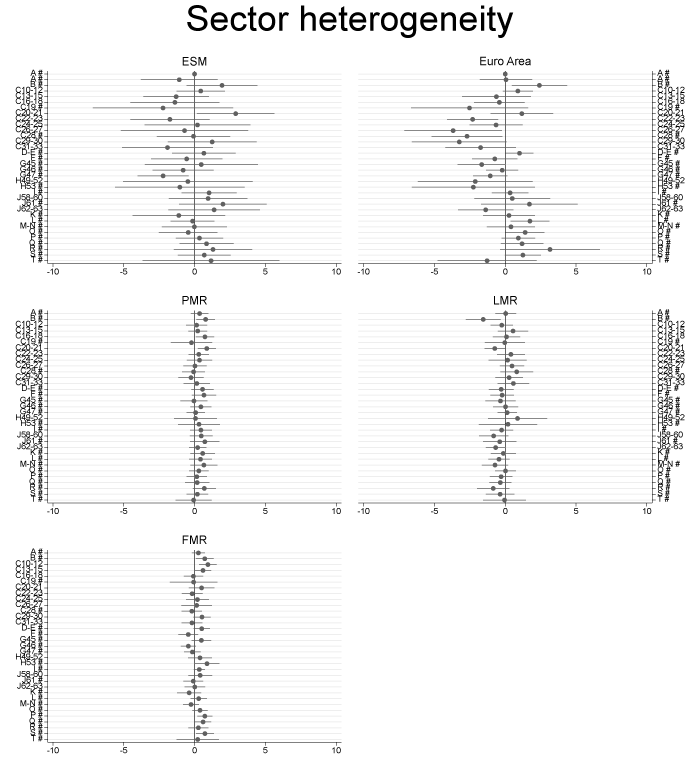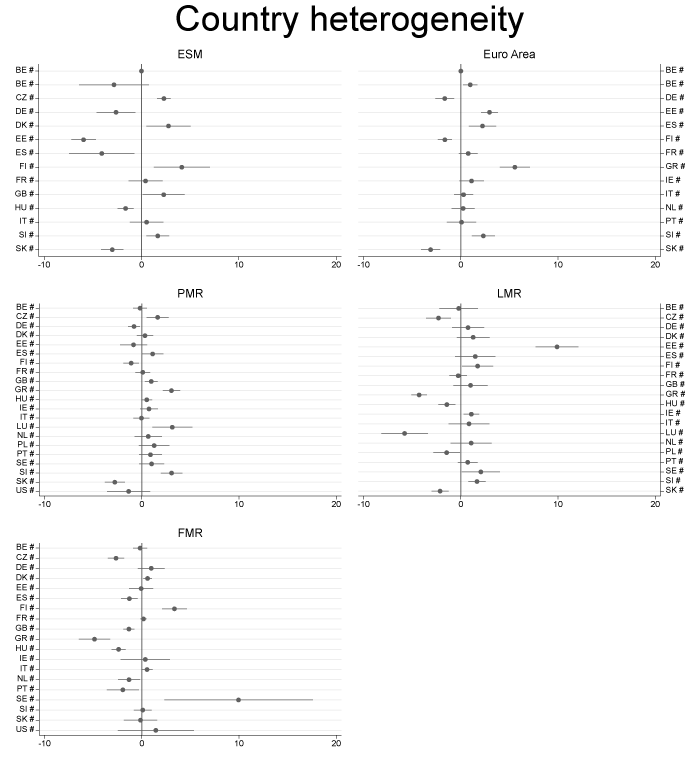It has become almost uncontroversial that integration has produced winners and losers, with an increasing share of the gains going to highly skilled individuals or those who own capital. Yet the potential role of sectoral differences has not yet been fully explored. For example, integration may have disproportionately benefited the financial sector and disproportionately hurt manufacturing (Cecchetti and Kharroubi 2015).
In this column, we report on new research exploring the possibility that the difficulties in identifying the effects of integration come from heterogeneous impacts on sectors. More specifically, we explore two questions using the European experience. First, has integration helped or hindered the implementation of labour, financial, and product market structural reforms? Second, do the growth effects of these structural reforms vary across sectors more than they vary across countries?
Country heterogeneity is often mentioned as a major reason for the various difficulties in obtaining precise estimates. In Campos et al. (2020), we compare this argument with the yet unexplored idea that the difficulties in identifying the effects of European economic integration (euro and Single Market) stem from different economic sectors reacting in heterogeneous ways.
Three structural reforms and the growth effects of European integration
How does integration affect economic growth? There are direct effects through increased competition and indirect effects through structural reforms. Increased flexibility in product markets, financial regulations, and employment protection are expected to raise productivity by eliminating distortions, improving allocation, and increasing competition.
We contribute to the literature on integration, structural reforms, and their growth effects in three main ways. Firstly, we pay attention to the largely untested possibility of sectoral heterogeneity raised as a theoretical argument in the literature and contrast it with the relatively more common reasoning and evidence stressing country heterogeneity (Campos et al. 2019).
Secondly, we use more granular measures for labour, product, and financial market reforms. Almost without exception, previous studies focus on broad measures of product or labour market reforms. Because these are complex reforms, there could be significant differences in the effects of their component parts. We take the multidimensionality of these reforms seriously and compare them to the aggregate reform effects. For labour market reforms, we separate changes in labour laws that refer to permanent contract workers, or ‘insiders’, from those referring to temporary workers, or ‘outsiders’ (Adams et al. 2018). For product market reforms, we consider ‘entry barriers’, ‘public ownership’ and ‘price controls’ (OECD 2017). Finally, we separately analyse financial reforms regarding ‘credit market controls’, ‘market structure’, and ‘regulation and supervision’ (Denk and Gomes 2017).
Thirdly, our analysis spans up to 36 countries since the early 1970s and therefore more years and more countries than a series of previous studies (see Alesina et al. 2010, Galasso 2014, Dias da Silva et al. 2018). We capture the staggered introduction and enlargement of the Single Market and of the euro area. Our considerably longer time window encompasses more recent economic events such as the global crisis and the European sovereign debt crisis and allows us to estimate and compare short-term and long-term effects.
We formulate three main hypotheses: (i) integration promotes structural reforms, (ii) the Single Market and the euro have similar effects on reforms, and (iii) the growth effects of integration and reforms differ across sectors and countries.
We use ordinary least squares regressions with country, year, and sector fixed effects and estimate short-term and long-term results from event study models and based on comparisons with country and year samples as used in the seminal Alesina et al. (2010) paper.
Heterogeneous effects on reform but small sectoral growth effects of economic integration
There are three main findings. Firstly, and in line with previous studies (e.g. Alesina et al. 2010), we show that the Single Market and the euro foster reforms in product markets, but not in labour or financial markets. We find statistically significant results showing that Single Market membership decreases product market regulation by 0.09 points, which is smaller but comparable to the estimate of 0.11 in Alesina et al. (2010). Single Market membership thus explains about a tenth of the standard deviation (2.33) of product market regulation. The European Single Market was implemented through the gradual deregulation of product markets. Gutiérrez and Philippon (2018) argue that EU markets have become more competitive than US markets because of the pooling of competition policy competencies. Hence, a tight link between the Single Market and product market reforms is expected.
Secondly, and in contrast to previous studies, we find that the Single Market is at least as important as the euro in triggering product market reforms. In contrast, Alesina et al. (2010) estimate that the effect of the euro in promoting product market reforms was three times larger than that of the Single Market.
Thirdly, we find that the well-known difficulties in establishing robust effects of reforms on economic growth appear to be driven more by country than by sector heterogeneity. Figure 1 shows that there is very little sector heterogeneity with regard to the growth effects of the Single Market, the euro, product, labour, or financial market regulation at conventional levels of statistical significance. This evidence does not support the idea that sectoral heterogeneity is the root cause for the elusive effect of European integration and structural reforms on value-added growth. So, is country heterogeneity to blame after all?
Figure 1 Sectoral heterogeneities in growth effects
Notes: The coefficient plots show the estimated coefficients for the interaction between the sector dummies and the variables depicted in the title of the respective part (i.e., ESM, euro, PMR, FMR, and LMR). 95% confidence intervals are shown. There are 32 sectors available in the EU-KLEMS according to the ISIC Rev. 4 (NACE Rev. 2) industry classification. These sectors are listed in Table 2 of the codebook (as accessed July 15, 2020).
Figure 2 Country heterogeneities in growth effects
Notes: The coefficient plots show the estimated coefficients for the interaction between the country dummies and the variables depicted in the title of the respective part (i.e., ESM, euro, PMR, FMR and LMR). 95% confidence intervals are shown. The reason some countries are not included is because of multicollinearity.
Figure 2 shows these interaction coefficients. Our results suggest that indeed country heterogeneities carry the bulk of the burden for the insignificant effects of reforms and European integration on value-added growth which provides further confirmation to the results in Campos et al. (2019).
Concluding remarks
Using a much larger sample of countries, longer time windows, sectoral outcomes, more granular reform measures, and a more sophisticated empirical approach than most existing studies, we put forward three main conclusions. Firstly, our estimates confirm previous studies showing that the Single Market and the euro have triggered product market, but neither labour nor financial market, reforms. Secondly, in contrast to the existing literature, we find that the Single Market is no less important than the euro in triggering structural reforms. This difference between our results and previous findings is explained by our larger sample of countries and the extended time window and is confirmed by our more granular and detailed measures of reforms. Thirdly, we show that the well-known difficulties in establishing robust effects of reforms on growth seem driven substantially by country heterogeneity, and much less by sector heterogeneity.
We offer four main suggestions for future research. Firstly, we focused on product, financial, and labour market reforms, but future work should broaden this range and also include other reforms (such as tax and trade). Secondly, future research should try to study the role of firm heterogeneities in explaining the varied experiences with European integration and structural reforms. Thirdly, we have followed the literature in stressing the role of economic crises in general, and banking crises in particular. Future work should examine the relative importance of political and economic crises in driving structural reforms. A fourth suggestion is to evaluate the effects of major recent events (e.g. global crisis and COVID-19) on reforms and their economic effects, once the necessary data is available.
References
Adams, Z, L Bishop, S Deakin, C Fenwick, S Martinsson and G Rusconi (2019), “The economic significance of laws relating to employment protection and different forms of employment: Analysis of a panel of 117 countries, 1990–2013”, International Labour Review 158: 1-35.
Alesina, A, S Ardagna and V Galasso (2010), “The euro and structural reforms”, In A Alesina and F Giavazzi (eds.), Europe and the Euro, Chicago: University of Chicago Press, pp. 57-99.
Badinger, H (2007), “Has the EU's Single Market Programme Fostered Competition? Testing for a Decrease in Mark‐up Ratios in EU Industries”, Oxford Bulletin of Economics and Statistics 69(4): 497-519.
Baldwin, R E, F Skudelny and D Taglioni (2005), “Trade Effects of the Euro: Evidence from Sectoral Data”, ECB Working Paper 446.
Campos, N, F Coricelli and L Moretti (2019), “Institutional Integration and Economic Growth in Europe”, Journal of Monetary Economics 103(1): 88-104.
Campos, N, P De Grauwe and Y Ji (2018), “Structural Reforms, Growth and Inequality: An Overview of Theory, Measurement and Evidence”, In N Campos, P De Grauwe and Y Ji (eds.), The Political Economy of Structural Reforms in Europe, Oxford University Press, pp. 1-44.
Campos, N, V Eichenauer and J.-E. Sturm (2020), “Close Encounters of the European Kind: Economic Integration, Sectoral Heterogeneity and Structural Reforms”, European Economic Review, forthcoming.
Cecchetti, S and E Kharroubi (2015), “Why Does Financial Sector Growth Crowd Out Real Growth?”, CEPR Working Paper 10642.
Denk, O and G Gomes (2017), “Financial re-regulation since the global crisis? An index-based assessment”, OECD Economics Department Working Papers 1396.
Dias da Silva, A, A Givone and D Sondermann (2018), “When Do Countries Implement Structural Reforms”, in N Campos, P De Grauwe and Y Ji (eds.), The Political Economy of Structural Reforms in Europe, Oxford University Press, 45-88.
Gutiérrez, G and T Philippon (2018), “How EU markets became more competitive than U.S. markets: A study of institutional drift”, NBER WP 24700.
OECD (2017), “Regulation in Energy, Transport and Communications”, OECDStat, Downloaded on 5 June 2019.









